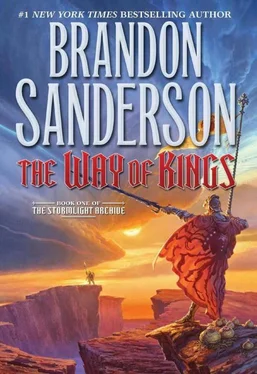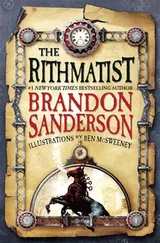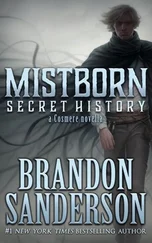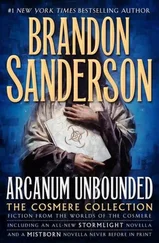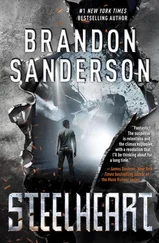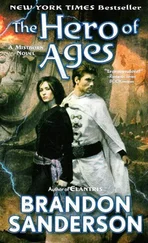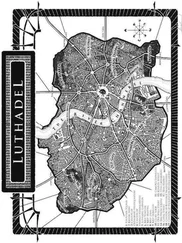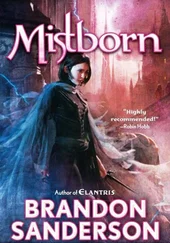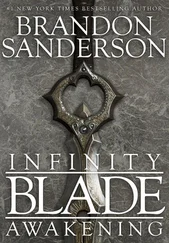He slumped forward, hitting the rocky ground, Shardblade clattering down behind him. It did not vanish. The guards inched forward. One prodded the man with the butt of his spear.
The man who had named himself a Herald did not move.
“What is it we value?” Wit whispered. “Innovation. Originality. Novelty. But most importantly… timeliness. I fear you may be too late, my confused, unfortunate friend.”
The end of
Book One of
THE STORMLIGHT ARCHIVE
“Above silence, the illuminating storms – dying storms – illuminate the silence above.”
The above sample is noteworthy as it is a ketek, a complex form of holy Vorin poem. The ketek not only reads the same forward and backward (allowing for alteration of verb forms) but is also divisible into five distinct smaller sections, each of which makes a complete thought.
The complete poem must form a sentence that is grammatically correct and (theoretically) poignant in meaning. Because of the difficulty in constructing a ketek, the structure was once considered the highest and most impressive form of all Vorin poetry.
The fact that this one was uttered by an illiterate, dying Herdazian in a language he barely spoke should be of particular note. There is no record of this particular ketek in any repository of Vorin poetry, so it is very unlikely that the subject was merely repeating something he once heard. None of the ardents we showed it to had any knowledge of it, though three did praise its structure and ask to meet the poet.
We leave it to His Majesty’s mind, on a strong day, to puzzle out the meaning of why the storms might be important, and what the poem may mean by indicating that there is silence both above and below said storms.
– Joshor, Head of His
Majesty’s Silent Gatherers,
Tanatanev 1173
The Ten Essences and Their Historical Associations
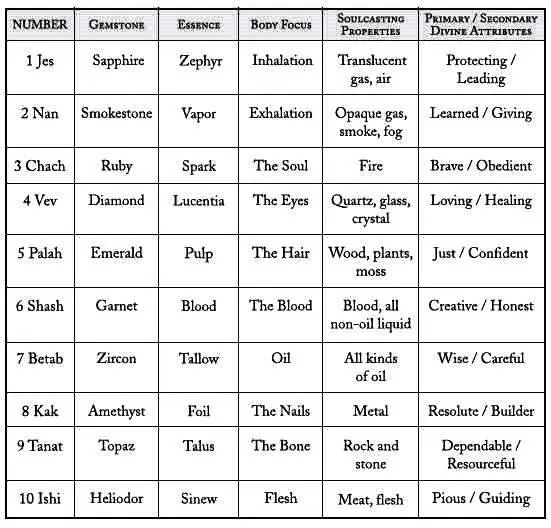
The preceding list is an imperfect gathering of traditional Vorin symbolism associated with the Ten Essences. Bound together, these form the Double Eye of the Almighty, an eye with two pupils representing the creation of plants and creatures. This is also the basis for the hourglass shape that was often associated with the Knights Radiant.
Ancient scholars also placed the ten orders of Knights Radiant on this list, alongside the Heralds themselves, who each had a classical association with one of the numbers and Essences.
I’m not certain yet how the ten levels of Voidbinding or its cousin the Old Magic fit into this paradigm, if indeed they can. My research suggests that, indeed, there should be another series of abilities that is even more esoteric than the Voidbindings. Perhaps the Old Magic fits into those, though I am beginning to suspect that it is something entirely different.
On the Creation of Fabrials
Five groupings of fabrial have been discovered so far. The methods of their creation are carefully guarded by the artifabrian community, but they appear to be the work of dedicated scientists, as opposed to the more mystical Surgebindings once performed by the Knights Radiant.
Altering Fabrials
Augmenters : These fabrials are crafted to enhance something. They can create heat, pain, or even a calm wind, for instance. They are powered – like all fabrials – by Stormlight. They seem to work best with forces, emotions, or sensations.
The so-called half-shards of Jah Keved are created with this type of fabrial attached to a sheet of metal, enhancing its durability. I have seen fabrials of this type crafted using many different kinds of gemstone; I am guessing that any one of the ten Polestones will work.
Diminishers : These fabrials do the opposite of what augmenters do, and generally seem to fall under the same restrictions as their cousins. Those artifabrians who have taken me into confidence seem to believe that even greater fabrials are possible than what have been created so far, particularly in regard to augmenters and diminishers.
Pairing Fabrials
Conjoiners : By infusing a ruby and using methodology that has not been revealed to me (though I have my suspicions), you can create a conjoined pair of gemstones. The process requires splitting the original ruby. The two halves will then create parallel reactions across a distance. Spanreeds are one of the most common forms of this type of fabrial.
Conservation of force is maintained; for instance, if one is attached to a heavy stone, you will need the same strength to lift the conjoined fabrial that you would need to lift the stone itself. There appears to be some sort of process used during the creation of the fabrial that influences how far apart the two halves can go and still produce an effect.
Reversers : Using an amethyst instead of a ruby also creates conjoined halves of a gemstone, but these two work in creating opposite reactions. Raise one, and the other will be pressed downward, for instance.
These fabrials have only just been discovered, and already the possibilities for exploitation are being conjectured. There appear to be some unexpected limitations to this form of fabrial, though I have not been able to discover what they are.
Warning Fabrials
There is only one type of fabrial in this set, informally known as the Alerter. An Alerter can warn one of a nearby object, feeling, sensation, or phenomenon. These fabrials use a heliodor stone as their focus. I do not know whether this is the only type of gemstone that will work, or if there is another reason heliodor is used.
In the case of this kind of fabrial, the amount of Stormlight you can infuse into it affects its range. Hence the size of gemstone used is very important.
Reports of the Assassin in White’s odd abilities have led me to some sources of information that, I believe, are generally unknown. The Windrunners were an order of the Knights Radiant, and they made use of two primary types of Surgebinding. The effects of these Surgebindings were known – colloquially among the members of the order – as the Three Lashings.
Basic Lashing: Gravitational Change
This type of Lashing was one of the most commonly used Lashings among the order, though it was not the easiest to use. (That distinction belongs to the Full Lashing below.) A Basic Lashing involved revoking a being’s or object’s spiritual gravitational bond to the planet below, instead temporarily linking that being or object to a different object or direction.
Effectively, this creates a change in gravitational pull, twisting the energies of the planet itself. A Basic Lashing allowed a Windrunner to run up walls, to send objects or people flying off into the air, or to create similar effects. Advanced uses of this type of Lashing would allow a Windrunner to make himself or herself lighter by binding part of his or her mass upward. (Mathematically, binding a quarter of one’s mass upward would halve a person’s effective weight. Binding half of one’s mass upward would create weightlessness.)
Multiple Basic Lashings could also pull an object or a person’s body downward at double, triple, or other multiples of its weight.
Full Lashing: Binding Objects Together
A Full Lashing might seem very similar to a Basic Lashing, but they worked on very different principles. While one had to do with gravitation, the other had to do with the force (or Surge, as the Radiants called them) of adhesion – binding objects together as if they were one. I believe this Surge may have had something to do with atmospheric pressure.
Читать дальше
